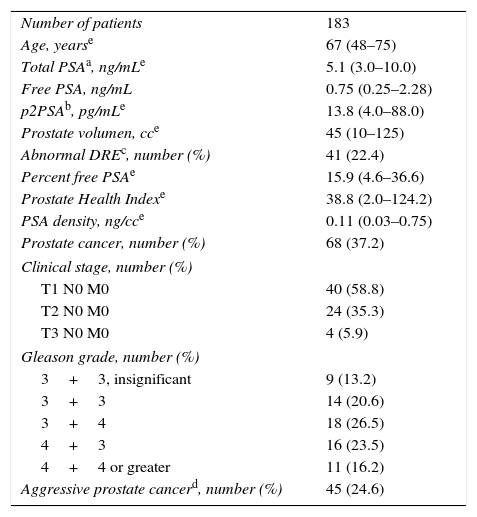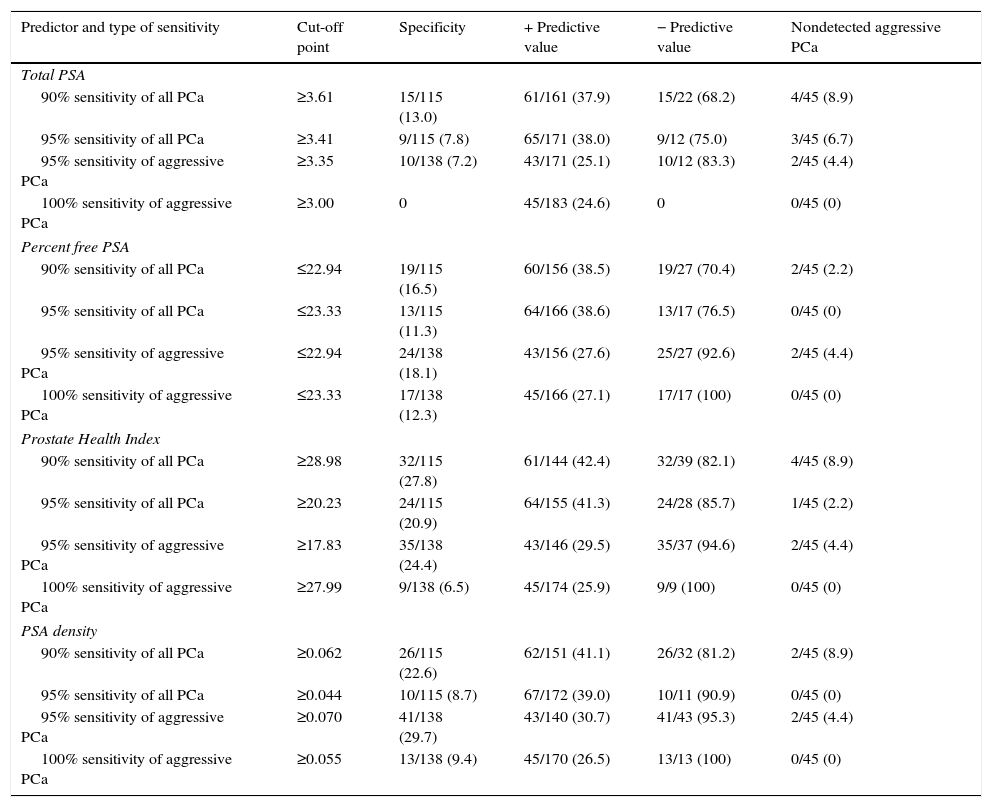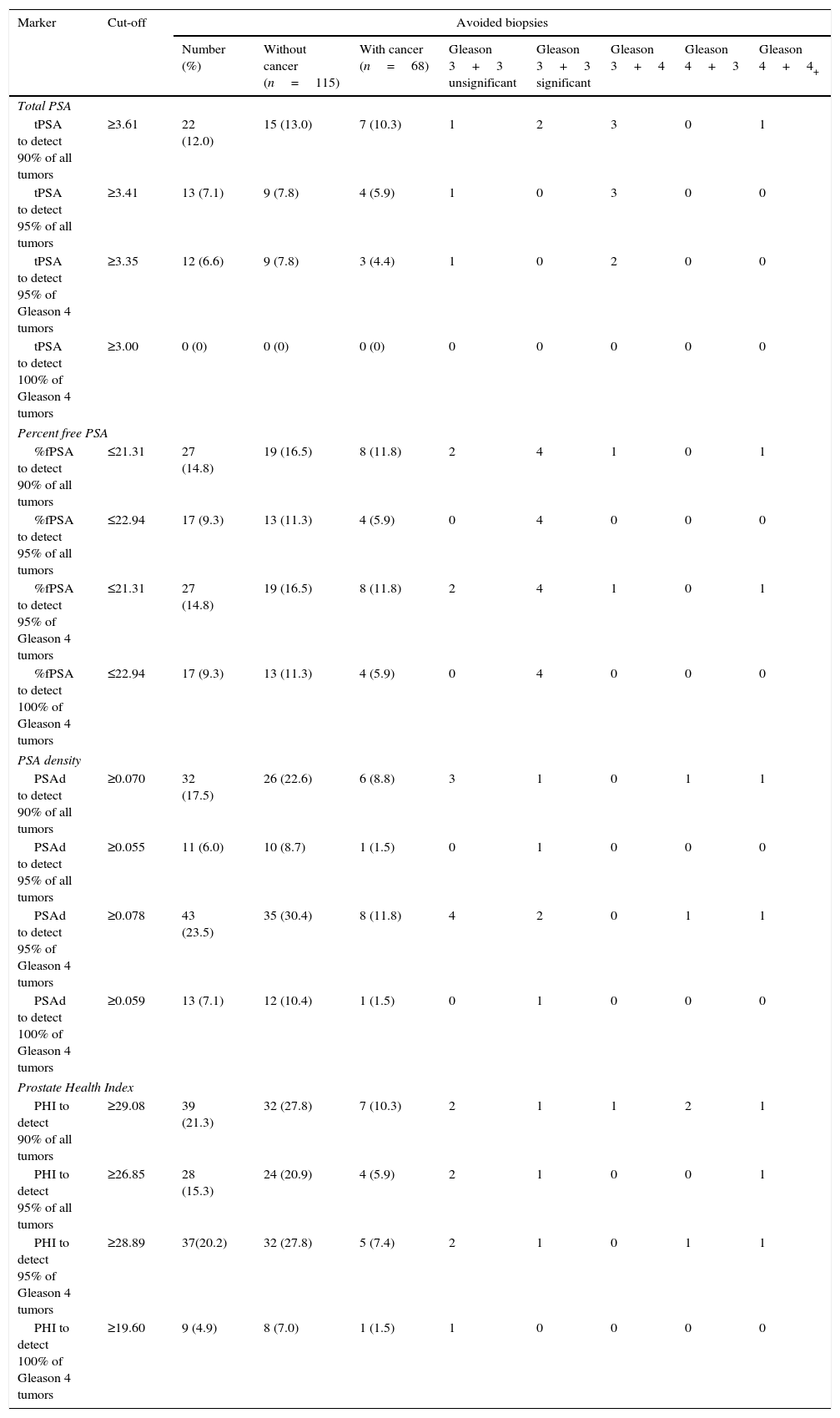New generations of tumor markers used to detect prostate cancer (PCa) should be able to discriminate men with aggressive PCa of those without PCa or nonaggressive tumors. The objective of this study has been to validate Prostate Health Index (PHI) as a marker of aggressive PCa in one academic institution.
MethodsPHI was assessed in 357 men scheduled to prostatic biopsy between June of 2013 and July 2014 in one academic institution. Thereafter a subset of 183 men younger than 75 years and total PSA (tPSA) between 3.0 and 10.0ng/mL, scheduled to it first prostatic biopsy, was retrospectively selected for this study. Twelve cores TRUS guided biopsy, under local anesthesia, was performed in all cases. Total PSA, free PSA (fPSA), and [-2]proPSA (p2PSA) and prostate volume were determined before the procedure and %fPSA, PSA density (PSAd) and PHI were calculated. Aggressive tumors were considered if any Gleason 4 pattern was found. PHI was compared to %fPSA and PSAd through their ROC curves. Thresholds to detect 90%, 95% of all tumors and 95% and 100% of aggressive tumors were estimated and rates of unnecessary avoided biopsies were calculated and compared.
ResultsThe rate of PCa detection was 37.2% (68) and the rate of aggressive tumors was 24.6% (45). The PHI area under the curve was higher than those of %fPSA and PSAd to detect any PCa (0.749 vs. 0.606 and 0.668 respectively) or to detect only aggressive tumors (0.786 vs. 0.677 and 0.708 respectively), however, significant differences were not found. The avoided biopsy rates to detect 95% of aggressive tumors were 20.2% for PHI, 14.8% for %fPSA, and 23.5% for PSAd. Even more, to detect all aggressive tumors these rates dropped to 4.9% for PHI, 9.3% for %fPSA, and 7.9% for PSAd.
ConclusionsPHI seems a good marker to PCa diagnosis. However, PHI was not superior to %fPSA and PSAd to identify at least 95% of aggressive tumors.
Las nuevas generaciones de marcadores tumorales para diagnosticar precozmente el cáncer de próstata (CaP) deberían ser capaces de discriminar entre pacientes portadores de tumores agresivos y aquellos sin cáncer, o con tumores de baja agresividad. El objetivo de este estudio ha sido validar en una institución académica el índice de salud prostática (PHI) como marcador de tumores agresivos de próstata.
MétodosSe determinó PHI en 357 varones sometidos a biopsia prostática entre junio de 2013 y julio de 2014. Posteriormente, un subgrupo de 183 hombres menores de 75 años, con PSA entre 3,0 y 10,0ng/ml y programados para su primera biopsia fue seleccionado para este estudio. En todos ellos se llevó a cabo una biopsia prostática transrectal, guiada por ultrasonidos y bajo anestesia local, que obtuvo 12 cilindros de la zona periférica. En todos los casos se determinó antes del procedimiento: PSA total (tPSA), PSA libre (fPSA), [-2] proPSA (p2PSA) y volumen prostático. Se calculó el porcentaje de fPSA (%fPSA), densidad de PSA (PSAd) y PHI. Se consideraron tumores agresivos aquellos que tuvieron algún patrón 4 en la biopsia. Se comparó PHI con %fPSA y PSAd a través del análisis de curvas ROC. Se establecieron dinteles para detectar el 90% y el 95% de todos los tumores y el 95% y el 100% de los tumores agresivos, y se calcularon las tasas de biopsias evitadas con cada uno de ellos.
ResultadosLa tasa global de detección de CaP fue del 37,2% y la de tumores agresivos del 24,6%. El área bajo la curva (AUC) de PHI para detectar cualquier tipo de tumor fue superior a la de %fPSA y PSAd (0,749 vs 0,606 y 0,668 respectivamente). De forma similar, cuando se consideraron solo los tumores agresivos las AUC fueron respectivamente 0,786 vs 0,677 y 0,708. La tasa de biopsias evitadas para detectar el 95% de los tumores agresivos fue del 20,2% para PHI, 14,8% para %fPSA y 23,5% para PSAd. Para detectar el 100% de tumores agresivos la tasa de biopsias evitadas cayó al 5,9% para PHI, 9,3% para %fPSA y 7,9% para PSAd.
ConclusionesPHI parece un buen marcador para diagnosticar el CaP. Sin embargo, cuando el objetivo es detectar al menos el 95% de los tumores agresivos no parece ser más eficaz que el %fPSA y la PSAd.
















